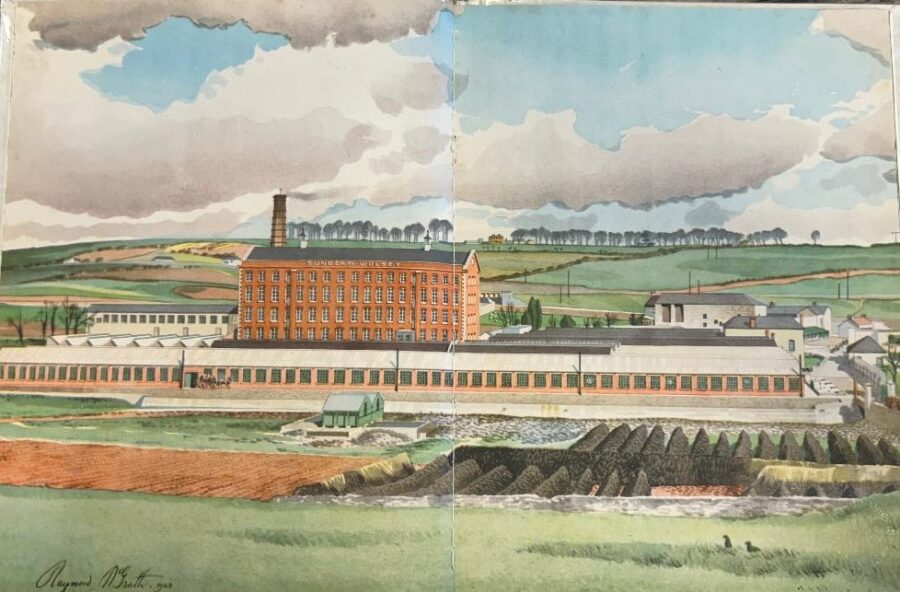
Kieran’s Our City, Our Town Article,
Cork Independent, 24 October 2024
Making an Irish Free State City – Opening the Sunbeam Knitwear Company in Blackpool
William Dwyer’s move from his factory in the historic Butter Exchange to Blackpool in the winter of 1932 was highly timely and strategic. More and more the Irish Free State Government, now under the fledging Fianna Fail party, was pushing for the creation of local and regional industries. To enable this, tariffs were also imposed on the imports of UK goods and a campaign of Buy Irish Goods pursued.
In an interview with the Cork Examiner on 19 October 1932, William Dwyer stated that the Sunbeam Knitwear Company had made arrangements for the making of silk and artificial silk hosiery in Cork. He deemed the premises in which the present factory was situated, the old Cork Butter Market, to have become too small for the expanding business. He had made arrangements for taking over an factory site in Millfield, Blackpool. He noted on his vision; “The making of Sunbeam hose, hosiery and underclothing would be carried out at the new factory. Within a short time we have employed eighty extra hands, and when the silk hosiery business would be started, we expect to employ about another hundred people”.
William continued in his interview that the chief difficulty, to that point in time experienced in the Irish Free State, in the making of silk hose was the dyeing and finishing of the goods. He added that the Sunbeam factory had obtained an expert, who was regarded as one of the best individuals in England in the art of dyeing and finishing hosiery.
The old Millfield building, a five storey brick building, was constructed between 1864 and 1866 and was the brainchild of William Shaw. Designed by Belfast architects, Boyd and Platt, it was the first industrial linen yarn-spinning mill outside of Ulster. The Millfield Mill was operated by the Cork Spinning and Weaving Company whose directors chose the site outside the city’s municipal boundary due to the fact, the company would not have to pay rates to Cork Corporation.
By January 1921, between 600 and 700 hands were made temporarily unemployed as a result of the closing of the flax mills of the Company due to difficult trading conditions. This action was rendered necessary by the fact that the company had sold very little of their stock within the previous few months, and indeed the whole trade was practically at a standstill.
Minister of Industry and Commerce Seán Lemass TD opened the new Messrs Sunbeam Knitwear Ltd factory on 5 March 1933. The Cork Examiner recorded in the ensuing days that a celebratory luncheon was given at the factory for over 100 guests. The Minister travelled from Dublin and was met at the gate by William Dwyer, the Lord Mayor of Cork, Cllr Seán French and Mr Hugo Flinn TD. Mr Lemass was cheered by an enthusiastic crowd as he made his way to the site for cutting a silk ribbon. The guests then retired to the factory’s dining hall whilst Mr Lemass was given a tour of the factory. Here he was shown the various stages of manufacture and notably the enterprise of silk stocking manufacture.
At the dining hall, Messrs F H Thompson and Son Ltd were the chosen caterers. William Dwyer proposed the toast of “Eire”, whilst Mr Charles Orr Stanley, Manager of the firm the toast of “Our Guests”. In replying to the toast, Minister Lemass thanked the Company for their hospitality and noted that the company was unique in many ways. That aside from political affiliations and occupations, any addition to industrial development would lead to “prosperity of their country and to abolish it from the curse of unemployment”.
Elaborating Minister Lemass that the Sunbeam company was eliminating the illusion, which existed amongst some sections of Irish Society that Irish industry cannot be as efficient as that what exists in the UK. Mr Lemass noted he was impressed by not merely the general lay-out of the factory and efficiency of the machinery that had been installed, but also what could be done by Irish workers.
Minister Lemass outlined that Mr Dwyer had told him of the experience of the highly skilled foreign operatives, who had been brought into to train Irish workers. He believed that Sunbeam was part of the idea that considerable progress could be made to supply the nation’s industrial requirements and that “greater progress was still possible” on sound economic principles as what were pursued by William Dwyer and his team.
On William Dwyer’s team as Co-Director was Waterford-born Charles Orr Stanley (1889-1989). The Oxford Dictionary of National Biography relates that Charles was an industrialist and specialised in telecommunications and marketing, which was to be of great use to the Sunbeam Knitwear Company. In 1923 Charles was employed at a London advertising agency. It specialised in advertisements for engineering concepts. The company led Charles to establish his own agency Arks Publicity and in 1924 he encouraged W G Pye of Cambridge to produce radios. Subsequently, Charles was employed by W G Pye to run the radio division of the company.
In 1928, Charles put down a deposit to buy Pye for £60,000 and in the ensuing year floated the company publicly. He was an early promoter in the potential of television and brought Pye to develop the concept of the television in 1928. They began producing 9-inch sets in 1935.
In 1932/33, Charles came in contact with William Dwyer. With marketing and industrialist experience, William persuaded Charles to be a Co-Director of Sunbeam. One can see Charles’s input in the advertisements in the Cork Examiner from 1930s onwards and the multiple write-ups and artistic spreads across the decade.
Caption:
1276a. Sketch of Sunbeam Knitwear Company Ltd, 1942 by Raymond McGrath (source: Cork City Library).